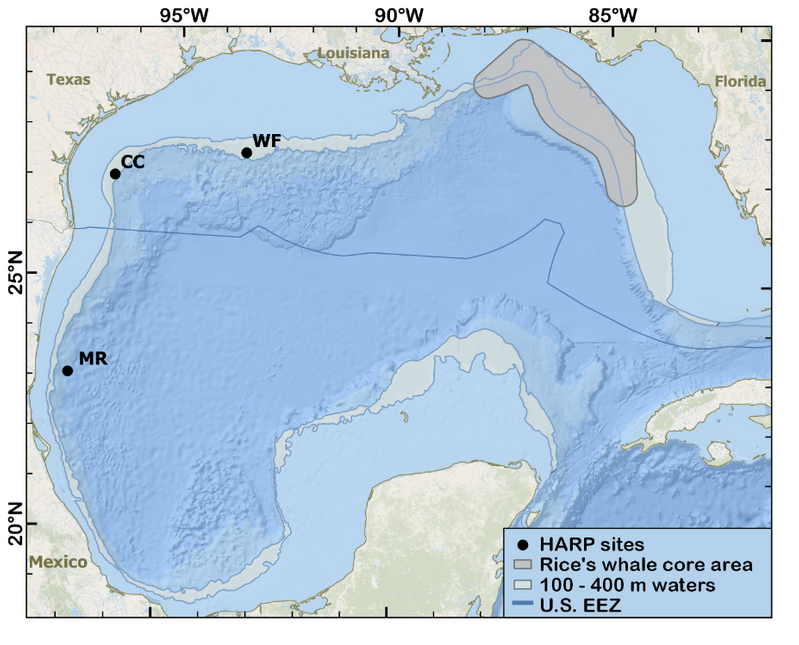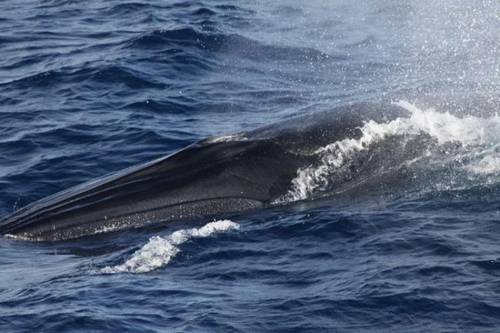Rice’s Whales Heard in the Western Gulf of Mexico
Evidence of endangered Rice’s whales has been recorded in the western Gulf of Mexico. These findings demonstrate their regular occurrence in waters offshore of Texas and the first evidence of Rice’s whales offshore of Mexico.
For the past 25 years, Rice's whales have been consistently observed in the northeastern Gulf of Mexico. They have been seen along the continental shelf break in waters roughly between 100 and 400 meters deep. In 2017, a single Rice’s whale sighting was confirmed in the western Gulf of Mexico off the coast of Texas, suggesting that their distribution may extend further west. New science led by NOAA Fisheries provides more evidence that these whales may be more prevalent in the western Gulf of Mexico than previously thought.
Listening for Rice’s Whales
Melissa Soldevilla, Ph.D., of the NOAA Fisheries Southeast Fisheries Science Center led an international team of researchers that used passive acoustic recorders called High-frequency Acoustic Recording Packages to listen for Rice’s whales in the western Gulf of Mexico. The recorders were moored to the seafloor for up to 2 years and captured ocean sound from a variety of sources, including whale sounds. The team used specialized software to analyze the recordings for Rice’s whale calls, which were then validated manually by an experienced acoustic analyst.
The team deployed these long-term passive acoustic recorders offshore of Louisiana and Texas for 356 days, and in Mexican waters for 680 days. They detected Rice’s whale calls on 25 percent of days recorded offshore of Texas, and 33 percent of days recorded off Louisiana. These findings provide additional support for Rice's whales' persistent occurrence in the western Gulf, including new information demonstrating their regular occurrence in waters offshore of Texas.
 Diagram of a High-Frequency Acoustic Recording Package (HARP). From top to bottom, the HARP includes floatation, a hydrophone (a device that detects underwater sound), a titanium cage protecting the data logger and batteries, an acoustic release that allows the instrument to return to the surface for retrieval, and an anchor to secure the device to the seafloor during the recording interval. Credit: Scripps Whale Acoustics Laboratory
Diagram of a High-Frequency Acoustic Recording Package (HARP). From top to bottom, the HARP includes floatation, a hydrophone (a device that detects underwater sound), a titanium cage protecting the data logger and batteries, an acoustic release that allows the instrument to return to the surface for retrieval, and an anchor to secure the device to the seafloor during the recording interval. Credit: Scripps Whale Acoustics Laboratory
Even more striking was the detection of Rice’s whale calls on 15% of days recorded offshore of Mexico, at sporadic intervals throughout the year. This provides the first evidence that Rice’s whales occur in Mexican waters.
The paper, "Rice's whale occurrence in the western Gulf of Mexico from passive acoustic recordings", was published in the Marine Mammal Science journal on February 13, 2024.
What this means for Rice’s whales
This discovery has many implications for the management and conservation of Rice’s whales. The results of this research will be used to inform management decisions for this endangered species.
 Three locations where Rice’s whales were detected with High-frequency Acoustic Recording Packages (HARPs, represented by black dots) in the western Gulf of Mexico. Rice’s whale core distribution area (as of June 2019; medium gray polygon), the region with 100 - 400 meter water depths (light gray polygon), and the U.S. Exclusive Economic Zone (blue line) are shown. HARP site names: CC = Corpus Christi; MR = Mexican Ridges; WF = Flower Garden West. Credit: NOAA Fisheries
Three locations where Rice’s whales were detected with High-frequency Acoustic Recording Packages (HARPs, represented by black dots) in the western Gulf of Mexico. Rice’s whale core distribution area (as of June 2019; medium gray polygon), the region with 100 - 400 meter water depths (light gray polygon), and the U.S. Exclusive Economic Zone (blue line) are shown. HARP site names: CC = Corpus Christi; MR = Mexican Ridges; WF = Flower Garden West. Credit: NOAA Fisheries
These findings also highlight the importance of continuing surveys into these waters to refine future population estimates and track the Rice’s whale population status. NOAA Fisheries continues to conduct research on these whales to better understand them and plan for recovery of their population. Ongoing research on Rice’s whales includes studying their trophic interactions and habitat requirements, conducting stock assessments, observing whales on vessel-based visual surveys and leading acoustic studies to better understand Rice’s whale distribution, movement, and behavior,
Rice’s whales face threats that contribute to their risk of extinction such as vessel strikes, noise from vessels and energy exploration, oil spills and other pollutants, including lingering effects of the Deepwater Horizon oil spill, ingestion of and entanglement in marine debris, climate change and its effect on prey and entanglement in fishing gear.
Rice’s whales are listed as an endangered species under the Endangered Species Act, and is protected under the Marine Mammal Protection Act. They are also a part of NOAA Fisheries’ Species in the Spotlight initiative, which brings greater attention and leverages partnerships and resources to save this highly at-risk species.
Partnerships
This work involved many researchers from these partner institutions:
- Scripps Institution of Oceanography
- University of Miami
- Universidad Veracruzana
- Universidad Nacional Autonoma de Mexico














 August 2025
August 2025



